Different responses of weather factors on hand, foot and mouth disease in three different climate areas of Gansu, China
- PMID: 29310596
- PMCID: PMC5759838
- DOI: 10.1186/s12879-017-2860-4
Different responses of weather factors on hand, foot and mouth disease in three different climate areas of Gansu, China
Abstract
Background: To determine the linear and non-linear interacting relationships between weather factors and hand, foot and mouth disease (HFMD) in children in Gansu, China, and gain further traction as an early warning signal based on weather variability for HFMD transmission.
Method: Weekly HFMD cases aged less than 15 and meteorological information from 2010 to 2014 in Jiuquan, Lanzhou and Tianshu, Gansu, China were collected. Generalized linear regression models (GLM) with Poisson link and classification and regression trees (CART) were employed to determine the combined and interactive relationship of weather factors and HFMD in both linear and non-linear ways.
Results: GLM suggested an increase in weekly HFMD of 5.9% [95% confidence interval (CI): 5.4%, 6.5%] in Tianshui, 2.8% [2.5%, 3.1%] in Lanzhou and 1.8% [1.4%, 2.2%] in Jiuquan in association with a 1 °C increase in average temperature, respectively. And 1% increase of relative humidity could increase weekly HFMD of 2.47% [2.23%, 2.71%] in Lanzhou and 1.11% [0.72%, 1.51%] in Tianshui. CART revealed that average temperature and relative humidity were the first two important determinants, and their threshold values for average temperature deceased from 20 °C of Jiuquan to 16 °C in Tianshui; and for relative humidity, threshold values increased from 38% of Jiuquan to 65% of Tianshui.
Conclusion: Average temperature was the primary weather factor in three areas, more sensitive in southeast Tianshui, compared with northwest Jiuquan; Relative humidity's effect on HFMD showed a non-linear interacting relationship with average temperature.
Keywords: Classification and regression tree; Climate change; Generalized linear model; Hand, foot and mouth disease.
Conflict of interest statement
Ethics approval and consent to participate
This data analysis was solely based on weekly aggregated data exported from the national infectious disease surveillance system. Thus, no ethical approval was required for this study.
Consent for publication
Not applicable
Competing interests
The authors declare that they have no competing interests.
Publisher’s Note
Springer Nature remains neutral with regard to jurisdictional claims in published maps and institutional affiliations.
Figures
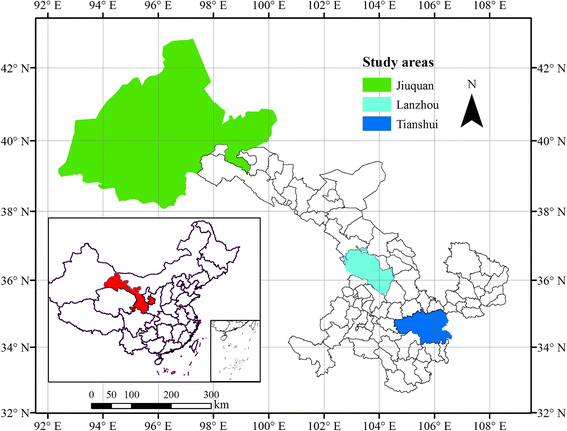
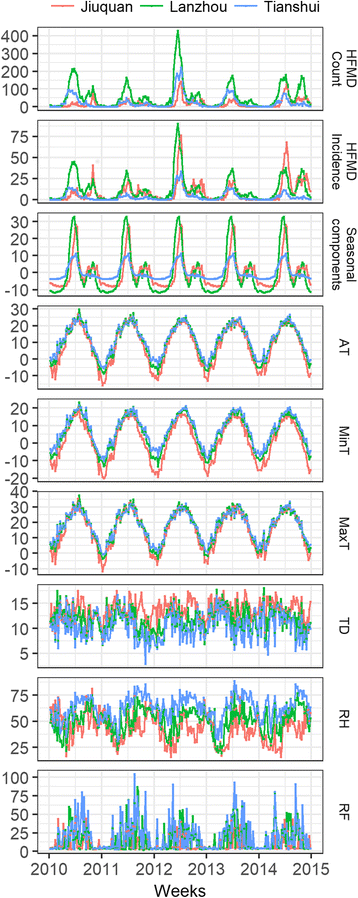
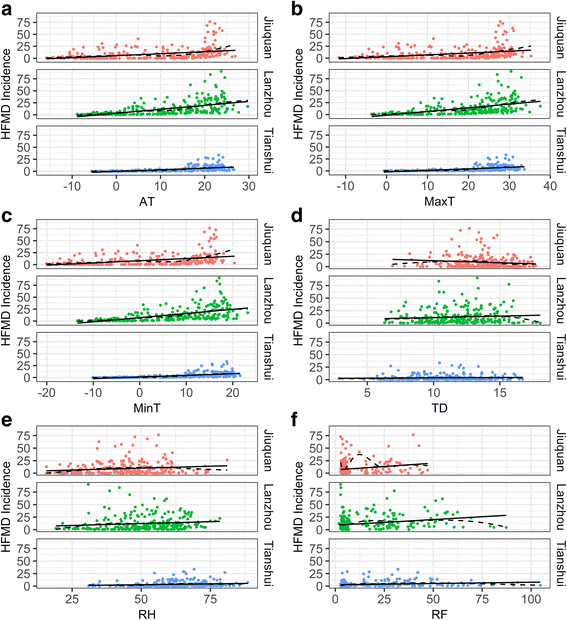
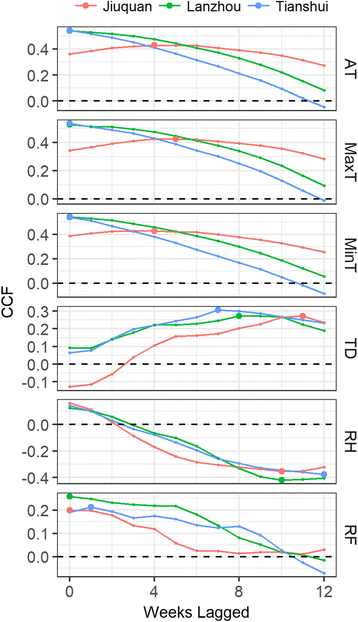
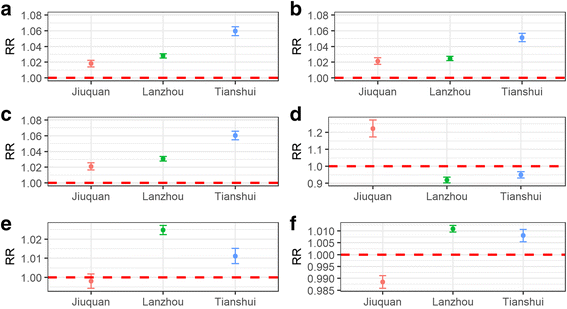
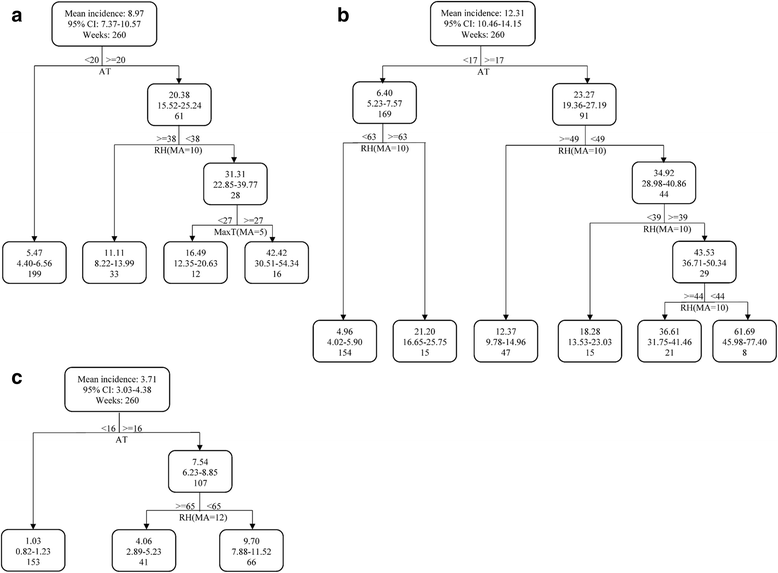
Similar articles
-
[Short term effect of weather patterns on the incidence of hand foot and mouth disease aged ≤5 years old in Jinan city].Zhonghua Yu Fang Yi Xue Za Zhi. 2015 Dec;49(12):1052-5. Zhonghua Yu Fang Yi Xue Za Zhi. 2015. PMID: 26887298 Chinese.
-
Impact of weather factors on hand, foot and mouth disease, and its role in short-term incidence trend forecast in Huainan City, Anhui Province.Int J Biometeorol. 2017 Mar;61(3):453-461. doi: 10.1007/s00484-016-1225-9. Epub 2016 Aug 24. Int J Biometeorol. 2017. PMID: 27557791
-
Seasonal modeling of hand, foot, and mouth disease as a function of meteorological variations in Chongqing, China.Int J Biometeorol. 2017 Aug;61(8):1411-1419. doi: 10.1007/s00484-017-1318-0. Epub 2017 Feb 10. Int J Biometeorol. 2017. PMID: 28188360
-
Association of Short-Term Exposure to Meteorological Factors and Risk of Hand, Foot, and Mouth Disease: A Systematic Review and Meta-Analysis.Int J Environ Res Public Health. 2020 Oct 30;17(21):8017. doi: 10.3390/ijerph17218017. Int J Environ Res Public Health. 2020. PMID: 33143315 Free PMC article.
-
Temperature and humidity affect the incidence of hand, foot, and mouth disease: a systematic review of the literature - a report from the International Society of Dermatology Climate Change Committee.Int J Dermatol. 2019 Apr;58(4):388-399. doi: 10.1111/ijd.14188. Epub 2018 Sep 5. Int J Dermatol. 2019. PMID: 30187452
Cited by
-
Assessing the modification impact of vaccination on the relationship of the Discomfort Index with hand, foot, and mouth disease in Guizhou: A multicounty study.PLoS Negl Trop Dis. 2024 Jul 1;18(7):e0012008. doi: 10.1371/journal.pntd.0012008. eCollection 2024 Jul. PLoS Negl Trop Dis. 2024. PMID: 38949988 Free PMC article.
-
Influencing factors of hand, foot, and mouth disease based on structural equation modeling in Hubei, China.Sci Rep. 2025 Jan 28;15(1):3571. doi: 10.1038/s41598-025-87853-4. Sci Rep. 2025. PMID: 39875454 Free PMC article.
-
Spatial-temporal heterogeneity of hand, foot and mouth disease and impact of meteorological factors in arid/ semi-arid regions: a case study in Ningxia, China.BMC Public Health. 2019 Nov 8;19(1):1482. doi: 10.1186/s12889-019-7758-1. BMC Public Health. 2019. PMID: 31703659 Free PMC article.
-
Short-term effects of meteorological factors, air pollution, and sunspot on childhood hand, foot, and mouth disease in Tianjin, China: a new time series regression, 2014-2018.Environ Sci Pollut Res Int. 2020 Oct;27(29):37022-37035. doi: 10.1007/s11356-020-09794-x. Epub 2020 Jun 23. Environ Sci Pollut Res Int. 2020. PMID: 32577970 Free PMC article.
-
Interaction analysis on transmissibility of main pathogens of hand, foot, and mouth disease: A modeling study (a STROBE-compliant article).Medicine (Baltimore). 2020 Mar;99(11):e19286. doi: 10.1097/MD.0000000000019286. Medicine (Baltimore). 2020. PMID: 32176053 Free PMC article.
References
Publication types
MeSH terms
Grants and funding
LinkOut - more resources
Full Text Sources
Other Literature Sources

